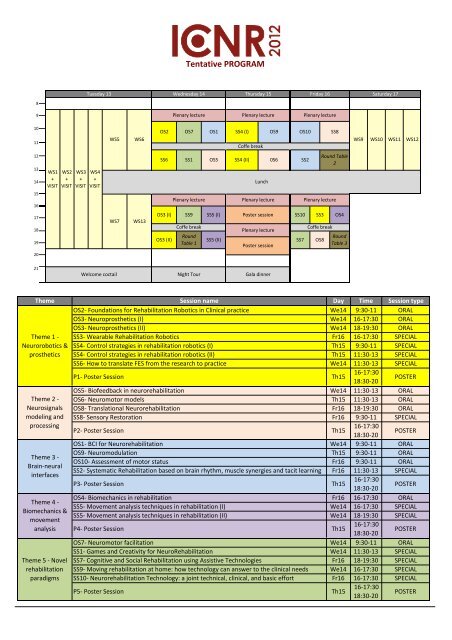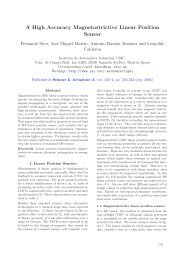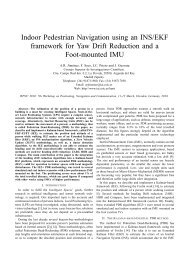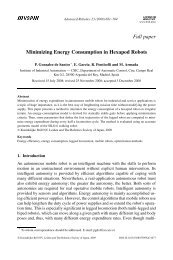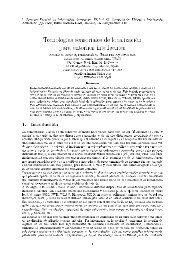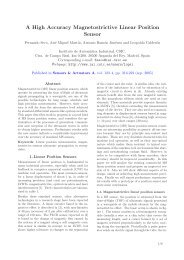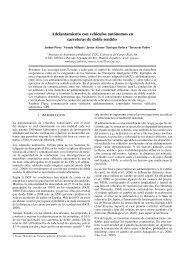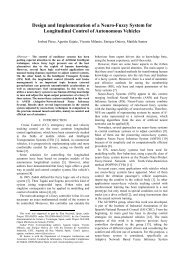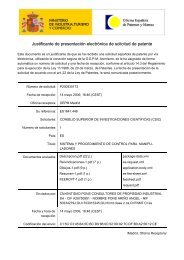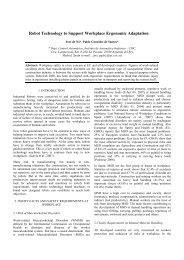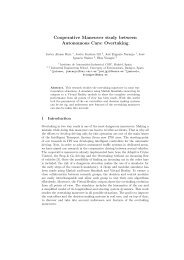Tentative PROGRAM - Centro de Automática y Robótica
Tentative PROGRAM - Centro de Automática y Robótica
Tentative PROGRAM - Centro de Automática y Robótica
You also want an ePaper? Increase the reach of your titles
YUMPU automatically turns print PDFs into web optimized ePapers that Google loves.
<strong>Tentative</strong> <strong>PROGRAM</strong>>)+2J0.E("5 32012J0.E("K )&+,J0.E("H M,$0.E("L4.'+,0.E("?ID/21.,E(/29'+,2D/21.,E(/29'+,2D/21.,E(/29'+,2"=""34H34L$%B2(0'80'.,32,-6.%CDDE 92:; :H$:? !1@AL32P2%:%$% "">$%92+0+452%123+4-5-,+,-')%1'4',-6. &0:F :F$:G=>? "IJ7D@AB2(0'0'4',-6.%Z% "";$%7'),0'5%.,0+,2K-2.%-)%023+4-5-,+,-')%0'4',-6.%CDE L3:M ?$:: "IJ7D@A80'.,32,-6. "";$%7'),0'5%.,0+,2K-2.%-)%023+4-5-,+,-')%0'4',-6.%CDDE L3:M ::=>?$:> "IJ7D@A""F$%N'O%,'%,0+).5+,2%&J"%/0'P%,32%02.2+063%,'%80+6,-62 92:; ::=>?$:> "IJ7D@AL32P2%#%$%B2(0'.-K)+5.%P'*25-)K%+)*%80'62..-)KL32P2%>%$%%%%%%%%Q0+-)$)2(0+5%-),20/+62.L32P2%;%$%Q-'P263+)-6.%Z%P'V2P2),%+)+5S.-.L32P2%M%$%B'V25%023+4-5-,+,-')%8+0+*-KP.I:$%I'.,20%"2..-')L3:M:F$:G=>?%:H=>?$#?I!"LJ1!"M$%Q-'/22*4+6R%-)%)2(0'023+4-5-,+,-') 92:; ::=>?$:> !1@A!"F$%B2(0'P','0%P'*25. L3:M ::=>?$:> !1@A!"H$%L0+).5+,-')+5%B2(0'023+4-5-,+,-') &0:F :H$:? !1@A""H$%"2).'0S%12.,'0+,-') &0:F ?$:: "IJ7D@AI#$%I'.,20%"2..-')L3:M:F$:G=>?%:H=>?$#?I!"LJ1!":$%Q7D%/'0%B2(0'023+4-5-,+,-') 92:; ?$:: !1@A!"$%I'.,20%"2..-')L3:M:F$:G=>?%:H=>?$#?I!"LJ1!";$%Q-'P263+)-6.%-)%023+4-5-,+,-') &0:F :F$:G=>? !1@A""M$%U'V2P2),%+)+5S.-.%,263)-W(2.%-)%023+4-5-,+,-')%CDE 92:; :F$:G=>? "IJ7D@A""M$%U'V2P2),%+)+5S.-.%,263)-W(2.%-)%023+4-5-,+,-')%CDDE 92:; :H$:? "IJ7D@AI;$%I'.,20%"2..-')L3:M:F$:G=>?%:H=>?$#?I!"LJ1!"G$%B2(0'P','0%/+6-5-,+,-') 92:; ?$:: !1@A"":$%X+P2.%+)*%702+,-V-,S%/'0%B2(0'123+4-5-,+,-') 92:; ::=>?$:> "IJ7D@A""G$%7'K)-,-V2%+)*%"'6-+5%123+4-5-,+,-')%(.-)K%@..-.,-V2%L263)'5'K-2. &0:F :H$:? "IJ7D@A""
P1.2Lokomat training, cervical versus thoracic spinal cord injuries. Comparative study.Mónica Alcobendas, Ana Esclarín and Rosa CasadoP1.3Exoskeletal Neuro-‐Rehabilitation in Chronic Paraplegic Patients – Initial ResultsMirko Aach, Tomohiro Hayashi, Irene Lange, Renate Meindl, Martin Tegenthoff, Peter Schwenkreis, Volkmar Nicolas, Yoshiyuki Sankai and Thomas SchildhauerP1.4 Customized Robot Ai<strong>de</strong>d Gait Training for NeuroRehabilitationShahid Hussain and Sheng Xie P1.5NASA-‐TLX Assessment of Mo<strong>de</strong>rn Close Loop Controllers in Haptic Guidance for Assisted RehabilitationJose Andres Turijan and Francisco J Ruiz-‐SanchezP1.6 Ursus: a robotic assistant for training of children with motor impairmentsCristina Suarez-‐Mejías, Carmen Echevarría, Pedro Nuñez, Luis Manso, Pablo Busto, Sandra Leal and Carlos ParraP1.7P1.8P1.9Design of a pediatric exoskeleton for the rehabilitation of the physical disabilities caused by cerebral palsyAugmenting Rehabilitation after Stroke: A Flexible Platform for Combining Multi-‐channel Biofeedback with FESRobotic Design of an Upper Limb Exoskeleton for Motion Analysis and Rehabilitation of Paediatric Neuromuscular Disor<strong>de</strong>rsMarina Canela Respuela and Jose Luis Pons RoviraSubhasis Banerji, John Heng, P S Ponvignesh and Daphne D. MenezesAlejandro Lugo-‐Villeda, Francisco J. Ruiz-‐Sánchez, Omar Dominguez-‐Ramirez and Vicente Parra VegaP1.10 Multimodal Robotic Device to assistive and rehabilitation tasksFrancisco J. Ba<strong>de</strong>sa, Ricardo Morales, Nicolas Garcia-‐Aracil, Jose Maria Sabater, Eugenia Papeleo, Loredana Zollo and Eugenio GuglielmelliP1.11Switching between the mo<strong>de</strong>s of control: Implications for the closed loop control of prosthesesMarko Markovic, Strahinja Dosen and Dario FarinaP1.12 Functional Electrical Stimulation Controller based on Muscle SynergiesWalter Denis, Fernando Brunetti, Stefano Piazza, Diego Torricelli and José Luis Pons
Theme 2 -‐ Neurosignals mo<strong>de</strong>ling and processingOral SessionOS5.1ContributionOS5-‐ Biofeedback in neurorehabilitationA Rehabilitation Robot for Training based on Visual Feedback DistortionAuthorsDay TimeWe14 11:30-‐13Patrick Weiss, Marcus Heldmann, Thomas Münte, Achim Schweikard and Erik MaehleOS5.2OS5.3OS5.4OS5.5On feasibility of gaze and facial component tracking during robot assisted walkingMotor Learning in Children with Cerebral Palsy with Feedback of Principal Component Space of Reduced DimensionA Comparison between Influence of Visual and Haptic Feedback on Jerk Indicators in Hand ExercisesDevelopment of an Experimental Set-‐up for Providing Lower-‐Limb Amputees with an Augmenting FeedbackSimon Zelič, Ales Holobar and Matjaz Divjak Citlali Lopez-‐Ortiz, Julia Simkowski, Wendolyn Gomez, Nikolay Stoykov and Deborah Gaebler-‐SpiraBaldassarre D'Elia, Maurizio Schmid, Ivan Bernabucci and Tommaso D'AlessioSimona Crea, Nicola Vitiello, Stefano Marco Maria De Rossi, Tommaso Lenzi, Marco Donati, Christian Cipriani and Maria Chiara CarrozzaOral SessionOS6.1OS6.2ContributionOS6-‐ Neuromotor mo<strong>de</strong>lsKnee muscle fatigue estimation during isometric artificially elicited contractions in incomplete spinal cord injured subjects.Animal mo<strong>de</strong>l to investigate the role of the motor cortex during treadmill locomotion in ratsDayTh15Time11:30-‐13AuthorsAntonio J. Del-‐Ama, Elisabeth Bravo-‐Esteban, Juan C. Moreno, Julio Gómez-‐Soriano, Stefano Piazza, Aikaterini D. Koutsou, Ángel Gil-‐Agudo and Jose L. PonsJakob Skriver Routhe, Marko Jörg Niemeier, Hans Christian Riis, Gynter Schnei<strong>de</strong>r and Winnie JensenOS6.3OS6.4Mo<strong>de</strong>ling Fatigue Effect in an EMG-‐Driven Hill Type Muscle Mo<strong>de</strong>l during Dynamic ContractionsInverse Estimation of Multiple Muscle Activations un<strong>de</strong>r Isokinetic ConditionDiana Ruiz Bueno and Luis MontanoZhan Li, Mitsuhiro Hayashibe and David GuiraudOral SessionContributionOS8-‐ Translational NeurorehabilitationAuthorsDayFr16Time18-‐19:30OS8.1Creating Intelligent Rehabilitation Technology: An Interdisciplinary EffortRosalie Wang, Jennifer Boger and Babak TaatiOS8.2OS8.3 Medical and Clinical Engineering CommitteeSelection of optimal candidate for patients with stroke involved in the robotic therapy for walking recovery: characterization of clinical and psychological featuresAntonio J. Del Ama and Susana BorromeoGiovanni MoroneSpecial SS8-‐ Sensory RestorationSessionContributionInfluence of myofascial therapy applied to the cervical region of patients SS8.1 suffering from unilateral spatial neglect and head <strong>de</strong>viation with respect to Ana Vaquero Rodríguezthe median lineAuthorsDayFr16Time9:30-‐11SS8.2Perception of Animated Spectrogram of Speech, A Multi-‐Word TestSomayeh Bazin and Ali Asghar Soltani FaraniSS8.3SS8.4Susana Borromeo, Cristina Gomez-‐Calero, Elena Molina, Javier Objective Assessment of A New Olfactory Rehabilitation Approach in Adults Fernan<strong>de</strong>z-‐Huete, Nieves Martinez-‐Monge, Adolfo Toledano, with Olfactory Impairments using Functional Magnetic Resonance (fMRI)Guilermo Luna and Juan Antonio Hernan<strong>de</strong>z-‐TamamesThe HyVE: Hybrid Vibro-‐Electrotactile stimulation for sensory feedback in upper limb prosthesesMarco D'Alonzo, Strahinja Dosen, Christian Cipriani and Dario Farina
SS8.5SS8.6Designing sensory neural prostheses -‐ Lessons to learn from auditory brainstem implantsVisual Neuroprosthesis: the relevance of plasticitySteffen Rosahl, Christos Pantazis and Sybille RosahlA Alfaro and Eduardo Fernán<strong>de</strong>zPoster SessionP2.1ContributionP2 -‐ Poster SessionIn vitro large polyfascicular nerve mo<strong>de</strong>l for assessment of fascicular recruitment characteristics of peripheral nerve interfacesP2.2 A Motion Library for Robot-‐based Upper Limb RehabilitationP2.3 Decoding Upper Limb Movement Velocity for Stroke RehabilitationAuthorsDayTh15Time16-‐17:3018:30-‐20Kristian Rauhe Harreby, Cristian Sevcencu and Winnie JensenFrank Domroes, Denis Stoerkle, Josef Ilmberger and Bernd Kuhlenkoetter.Enrique Hortal, Eduardo Iáñez, Andrés Úbeda, Daniel Tornero and José M. AzorínP2.4Chronic electrochemical investigation of titanium nitri<strong>de</strong> stimulation electro<strong>de</strong>s in vivoSuzan Meijs, Morten Fjorback and Nico RijkhoffP2.5 Hybrid Neuromusculoskeletal Mo<strong>de</strong>lingMassimo Sartori, Dario Farina and David LloydP2.6Protocol and system for spastic behavior simulation through the generation of cutaneous reflexesFrancisco Resquín, Elisabeth Bravo, Julio Gómez-‐Soriano, Fernando Brunetti and José Luis PonsP2.7 Towards Improving the Usability of Electromyographic InterfacesHugo Silva, Reinhold Scherer, Joana Sousa and Ana LondralP2.8P2.9Preliminary result from a multimodal interface for cerebral palsy users based on eye tracking and inertial technologySimulation of the Muscle Recruitment by Transcutaneous Electrical Stimulation in a Simplified Semitendinosus Muscle Mo<strong>de</strong>lAlejandro Clemotte, Rafael Raya, Ramón Ceres and Eduardo RoconJosé David Gómez Tames, José González, Shuto Nakamura and Wenwei YuP2.10 Ultrasound Imaging and Analysis of Muscle Activity in Lower LimbP2.11 Evaluation of IMU ZigBee Sensors for Upper Limb RehabilitationNakamura Shuto, Jose David Gomez-‐Tames, Jose Gonzalez, Ojima Sho, Yamaguchi Tadashi and Wenwei YuCarlos A. Cifuentes G., Ariel Braidot, Melisa Frisoli, Alfonso Santiago, Anselmo Frizera and Juan MorenoP2.12P2.13Postural Synergies and Neural Network for Autonomous Grasping: a Tool for Dextrous Prosthetic and Robotic HandsCase-‐Mix analysis of patients referred from the Public Health Services of Extremadura (SES) to the Monographic Rehabilitation Center for brain injuryFanny Ficuciello, Gianluca Palli, Claudio Melchiorri and Bruno SicilianoJose María Porto-‐Payán, Lorena María Lérida-‐Benítez, Ana María Roa-‐Montero, Albert Giménez-‐Soria, Manuel Menchón-‐Bofill and Cristina Tobón-‐ArbeláezP2.14 MAXSENS: A flexible matrix electro<strong>de</strong> for sensory substitutionLana Popovic-‐Maneski, Strahinja Dosen and Goran Bijelic
Theme 3 -‐ Brain-‐neural interfacesOral SessionOS1.1ContributionOS1-‐ BCI for NeurorehabilitationError Potential Detection to Assist Movement Intention Decoding in Stroke PatientsAuthorsDayWe14Time9:30-‐11Joaquín López, Andrés Úbeda, Eduardo Iáñez, José M. Climent and José M. AzorínOS1.2OS1.3OS1.4EMG topography of low back muscles as a tool for posture evaluation and for the assessment of lumbalgia treatments progressRandomized Controlled Trial to Evaluate a BCI-‐Supported Task-‐Specific Training for Hand Motor Recovery after StrokeClassification of stance and swing gait states during treadmill walking from non-‐invasive scalp electroencephalographic (EEG) signalsNadica Miljkovic, Haritz Zabaleta, Cristina Rodriguez-‐De-‐Pablo, Thierry Keller and Gonzalo GarciaFloriana Pichiorri, Giovani Morone, Iolanda Pisotta, Marco Secci, Febo Cincotti, Stefano Paolucci, Marco Molinari and Donatella Mattia Fernando San Martin Jorquera, Sara Grassi, Pierre-‐André Farine and Jose Luis Contreras-‐VidalOS1.5Motor imagery driven BCI with cue-‐based selection of FES induced graspsAndrej M. Savic, Nebojsa B. Malesevic and Mirjana B. PopovicOral SessionOS9.1OS9.2OS9.3ContributionOS9-‐ NeuromodulationImproved gait symmetry in hemiparetic patients following gait rehabilitation supported by activation of the nociceptive withdrawal reflex« Awake surgery » of slow-‐growing tumors and cortical excitability measured by EEG recordings. Preliminary results.Virtual cerebellar lesions influence verbal working memory: A tDCS studyAuthorsDayTh15Erika G. Spaich, Niels Svaneborg and Ole K. An<strong>de</strong>rsenFrançois Bonnetblanc, Guillaume Herbet, Pom Charras, Mitsuhiro Hayashibe, David Guiraud, Hugues Duffau and Bénédicte Poulin-‐CharronnatKatja Macher, Andreas Böhringer, Jürgen Dukart, Arno Villringer and Burkhard PlegerTime9:30-‐11OS9.4A simulation study to characterize the effects of frequency modulation during epidural electrical stimulationMarco Cempini, Gunter Kanitz, Marco Capogrosso, Stanisa Raspopovic and Silvestro MiceraOS9.5Tremor suppression using electromyography and surface sensory electrical Strahinja Dosen, Jakob Di<strong>de</strong>riksen, Eduardo Rocon, Jose Pons stimulationand Dario FarinaOral SessionContributionOS10-‐ Assessment of motor statusAuthorsDayFr16Time9:30-‐11OS10.1 Effects of bimanual motor learning on unimanual performanceMatic Trlep, Matjaž Mihelj and Marko MunihOS10.2 On repeatability of motor unit characterization in pathological tremorOS10.3Fast forms of central fatigue account for <strong>de</strong>creases in rate of execution during fast and short repetitive motor tasksIntersegmental synchronization of spontaneous cord dorsum potentials as Mario Martin, Diógenes Chávez, Javier Béjar, Gennaro OS10.4 a clinical parameter to evaluate changes in neuronal connectivity produced Esposito, Érika Rodríguez, Ulises Cortés and Pablo Rudomínby peripheral nerve and spinal cord damage.OS10.5Analysis of EEG Signal to Detect Motor Command Generation Towards Stroke RehabilitationPetra Povalej Bržan, Juan Gallego, Farina Farina and Ales HolobarPablo Arias, Verónica Robles-‐García, Yoanna Corral-‐Bergantiños, Nelson Espinosa, Kenneth L Grieve, Casto Rivadulla, Antonio Oliviero and Javier Cu<strong>de</strong>iroYoshikatsu Hayashi, Kiyoshi Nagai, Koji Ito, Slawomir Nasuto, Rui Loureiro and William HarwinSpecial SessionSS2.1SS2-‐ Systematic Rehabilitation based on brain rhythm, muscle synergies and tacit learningContributionVoluntary and Reflex Muscle Synergies in Upper LimbsAuthorsDayFr16Time11:30-‐13Tytus Wojtara, Fady Alnajjar, Shingo Shimoda and Hi<strong>de</strong>nori KimuraSS2.2The Rule of the Depen<strong>de</strong>ncy Level of the Sensory Synergy in Recruiting Muscle SynergyFady Alnajjar, Tytus Wojtara, Shingo Shimoda and Hi<strong>de</strong>nori Kimura
SS2.3Manipulative Evaluation of Alpha Bottom-‐up Networks in the Resting-‐state by Combined TMS-‐EEGMasahiro Kawasaki, Yuji Mizuno and Keiichi KitajoSS2.4SS2.5Trajectory optimization by Tacit learningChanges in corticospinal excitability following the use of a BCI based protocol combined with sham visual feedbackShingo Shimoda and Hi<strong>de</strong>nori KimuraSigne Kristensen, Imran Khan Niazi, Mads Jochumsen, Ning Jiang, Dario Farina and Natalie Mrachacz-‐KerstingPoster SessionContributionP3 -‐ Poster SessionAuthorsDayTh15Time16-‐17:3018:30-‐20P3.1 EEG-‐Eye blink <strong>de</strong>tection system for Brain Computer InterfaceP3.2P3.3Neurorehabilitation in chronic paraplegic patients with the HAL® Exoskeleton – preliminary electrophysiological and fMRI data of a pilot studyInvestigating the Neural Basis for Stroke Rehabilitation by Brain-‐Computer InterfacesSandy Rihana, Pascal Damien and Tony MoujaessMatthias Sczesny-‐Kaiser, Oliver Höffken, Silke Lissek, Melanie Lenz, Lara Schlaffke, Volkmar Nicolas, Renate Meindl, Mirko Aach, Yoshiyuki Sankai, Thomas A. Schildhauer, Martin Tegenthoff and Peter Schwenkreis Timm Meyer, Jan Peters, Thorsten Zan<strong>de</strong>r, Doris Brötz, Surjo Soekadar, Bernhard Schölkopf and Moritz Grosse-‐WentrupP3.4A Workstation for Development of Brain Machine Interfaces Using Spiking Neural NetworksMehmet Kocaturk, Halil Ozcan Gulcur and Resit CanbeyliP3.5P3.6P3.7Asynchronous BCIs for the early <strong>de</strong>tection and classification of voluntary movements: Applications in Stroke rehabilitationIndividual Evaluation of Interhemispheric Neural Synchrony mediating Perceptual Bias in Apparent Motion Perception -‐ A TMS-‐EEG study and applications in rehabilitation -‐A P300-‐based BCI Aimed at Managing Electronic Devices for People with Severe DisabilitiesP3.8 tDCS modulates motor imagery-‐related BCI featuresP3.9Sample-‐by-‐Sample Detection of Movement Intention from EEG using a Classifier with Optimized Decision ParametersP3.10 Using the Brain-‐rate as a preliminary indicator of general mental activationJaime Ibáñez, M. Dolores Del Castillo and J. Ignacion SerranoYuji Mizuno, Masahiro Kawasaki and Keiichi KitajoRebeca Corralejo, Daniel Álvarez and Roberto HorneroRicardo Chavarriaga, Andrea Biasiucci, Alberto Molina, Robert Leeb Leeb, Vanesa Soto Leon, Michela Campolo, Antonio Oliviero and José Del R. MillanWanjoo Park, Jae-‐Hwang Kang, Gyuhyun Kwon, Laehyun Kim and Sung-‐Phil KimSaso Koceski, Silvana Markovska-‐Simoska and Nada Pop-‐Jordanova
Theme 4 -‐ Biomechanics & movement analysisOral SessionOS4.1OS4.2OS4.3OS4.4ContributionDecoupling of the Centre of Mass (CoM) and centre of pressure (CoP) during gait initiation. Introduction of a new variableThe importance of gait analysis in incomplete spinal cord injury patients in field of neurorehabilitation A biomechanical mo<strong>de</strong>l for pathological tremor suppressionOS4-‐ Biomechanics in rehabilitationMuscle coherence during controlled voluntary movement in healthy subjects and patients with spinal cord injury: contraction and velocity <strong>de</strong>pen<strong>de</strong>nce.AuthorsDayFr16Marc Ne<strong>de</strong>rhand, Eric Prinsen and Hans Rietman Time16-‐17:30Soraya Pérez Nombela, Antonio José Del Ama Espinosa, Ana <strong>de</strong> Los Reyes Guzmán, Ángel Manuel Gil Agudo, Francisco Molina Rueda and Diego Torricellli Juan Manuel Belda Lois, Silvia Mena Del Horno, Ignacio Bermejo, Ascensión Castillo and Jerónimo SanchoElisabeth Bravo, Julio Gomez-‐Soriano, Manuel Aleixandre, Sergiu Albu, Cristina Simon, Diego Torricelli, Jose Luis Pons and Julian TaylorOS4.5So-‐called 'Foot-‐Drop' Post-‐stroke: Not a Dorsiflexor ImpairmentVirginia Little, Theresa McGuirk and Carolynn PattenSpecial SessionSS5.1SS5-‐ Movement analysis techniques in rehabilitation (I)ContributionValidation of Inverse Dynamics Mo<strong>de</strong>lling and Corelation Analysis to Characterise Upper-‐Limb TremorAuthorsDay TimeWe14 16-‐17:30David Western, Laurence Ketteringham, Simon Neild, Richard Hy<strong>de</strong>, Rosemary Jones and Angela Davies-‐SmithSS5.2Subject-‐specific Center of Mass Estimation for In-‐home Rehabilitation -‐ Kinect-‐Wii board vs. Vicon-‐Force plateAlejandro Gonzalez, Mitsuhiro Hayashibe and Philippe FraisseSS5.33D Reaching in Visual Augmented Reality using Kinect: the Perception of Virtual TargetMichela Goffredo, Maurizio Schmid, Silvia Conforto and Tommaso D'AlessioSS5.4SS5.5A wearable motion sensor for evaluating walking performance in Parkinson’s disease with treatmentsI<strong>de</strong>ntification and <strong>de</strong>composition of error in 3D motion capture using inertial and magnetic sensorsToshiyo Tamura and Masaki SekineStefan Lambrecht and José Luis PonsSpecial SessionSS5.6SS5-‐ Movement analysis techniques in rehabilitation (II)Contribution Measurement of Lower Limb Spasticity Using an Inertial SensorAuthorsDay TimeWe14 18-‐19:30Irma Sterpi, Alberto Caroli, Elisa Meazza, Giorgio Maggioni and Roberto ColomboSS5.7Walking in water and on land after an incomplete spinal cord injuryFe<strong>de</strong>rica Tamburella, Giorgio Scivoletto, Elena Cosentino and Marco MolinariSS5.8Comparative evaluation of gait event <strong>de</strong>tection methods based on a single IMU: error sensitivity analysis to IMU positioningDiana Trojaniello, Andrea Cereatti and Ugo Della CroceSS5.9SS5.10Estimate of lower trunk angles using gyroscope data in pathological gaitEffect of Gait Speed on Dynamic Postural Stability, Harmony and Upper Body AttenuationEleni Grimpampi, Vincent Bonnet, Antonio Taviani and Claudia MazzàPietro Scaglioni-‐Solano and Juan C. MorenoPoster SessionP4.1ContributionP4 -‐ Poster SessionStiff Knee Gait in adults with spastic paresis. A systematic review of the effects of chemo<strong>de</strong>nervation of the rectus femoris muscle.AuthorsDayTh15Time16-‐17:3018:30-‐20Marc Ne<strong>de</strong>rhand, Martin Tenniglo, Jaap Buurke, Anand Nene and Hans RietmanP4.2Detection of Rehabilitation-‐Relevant Events During En<strong>de</strong>ffector Based Robot Assisted Rehabilitation of Upper ExtremitiesMichael Hennes, Kai Bollue, Henry Arenbeck, Dirk Abel and Catherine Disselhorst-‐Klug
P4.3Instrumentation and biomechanical mo<strong>de</strong>l for kinematic and kinetic analysis of upper limbs during gait with crutches.P4.4 Functional Data Analysis for Gait Analysis after StrokeP4.5Specifying the gait phases of one leg using information of contralateral leg: Application to unilateral drop foot patientsEnrique Perez-‐Rizo, Angel Gil-‐Agudo, Marta Solis-‐Mozos, Juan Manuel Belda, Alvaro Page and Jose Luis Pons Juan Manuel Belda Lois, María José Vivas Broseta, Silvia Mena Del Horno, Maria Luz Sánchez Sánchez, Miguel Matas and Enrique VisocaAli Firouzabadi, Hamid Reza Kobravi, Hossein Asghar Hosseini and Neda KordjaziP4.6Muscular activation and kinetic effects of robotic guidance force on human walkingFilipe Barroso, José Pons and Juan MorenoP4.7 Static and Dynamic Body Analysis in Physiotherapy and RehabilitationMiguel Reyes, Albert Clapés, Luis Felipe Mejía, José Ramírez, Juan Ramón Revilla and Sergio EscaleraP4.8Joint Limit vs. Optimized Weighted Least Norm Methods in Predicting Upper Body PostureDerek Lura, Stephanie Carey and Rajiv DubeyP4.9 External support forces during assisted walking in a rehabilitation systemP4.10Modification of Lower Extremity Kinetic Symmetry During Sit-‐to-‐Stand Transfers Using a Wearable Robotic Leg Orthosis with Individuals Post-‐StrokeP4.11 A biomechanical mo<strong>de</strong>l for the validation of modular control in balanceEloy Uren<strong>de</strong>s Jimenez, Ramon Ceres Ruiz, Magdo Bortole and Jose Luis Pons RoviraJoshua Vose, Robert Horst Phd and Arlene McCarthy Pt Ms Dpt NcsStefano Piazza, Misagh Mansouri, Jeffrey A. Reinbolt, Diego Torricelli and José L. PonsP4.12Analysis of the effect of two different feedbacks on the biomechanical patterns of stroke patients during robotic-‐assisted gait rehabilitationIvan Collantes, Guillermo Asín, Juan Camilo Moreno and Jose Luis Pons
Theme 5 -‐ Novel rehabilitation paradigmsOral SessionOS7.1OS7.2OS7.3ContributionAnodal Transcranial Direct Current Stimulation over the Lower Limb Motor Cortex Increases the Cortical Excitability with Extracephalic Reference Electro<strong>de</strong>sA novel brain-‐computer interface for chronic stroke patientsOS7-‐ Neuromotor facilitationMapping Arm Movements to Robotic Sonic Interaction Promote Group Dynamics and Increase Engagement at a TaskAuthorsDayWe14Tsuyoshi Tatemoto, Tomofumi Yamaguchi, Yokei Otaka, Kunitsugu Kondo and Satoshi TanakaTime9:30-‐11Natalie Mrachacz-‐Kersting, Imran Niazi, Ning Jiang, Aleksandra M. Pavlovic, Sasa Radovanović, Vladimir Kostic, Dejan Popovic, Kim Dremstrup and Dario FarinaHoang Le, Martin Loomes and Rui LoureiroOS7.4Facilitating myoelectric-‐control with transcranial direct current stimulationAnirban Dutta and Michael A. NitscheSpecial SessionSS1.1SS1.2SS1-‐ Games and Creativity for NeuroRehabilitationContributionVirtual reality system Toyra. A new tool to assess and treatment for upper limb motor impairment in patients with spinal cord injuryFirst results of a comparison between gaming and conventional exercises to improve arm function after chronic strokeAuthorsDay TimeWe14 11:30-‐13Iris Dimbwadyo Terrer, Ana De Los Reyes, Alberto Bernal Sahún, Patricia López Monteagudo, Fernando Trincado Alonso, Begoña Polonio López and Ángel Manuel Gil AgudoGerdienke Prange, Anke Kottink, Thijs Krabben, Johan Rietman and Jaap BuurkeSS1.3SS1.4SS1.5Use of virtual reality systems in cerebral palsy: updated clinical practice gui<strong>de</strong>line.Evaluation of the use of a virtual reality vi<strong>de</strong>o-‐game system as a supplement for rehabilitation of children with cerebral palsyPatient Tailored Virtual RehabilitationEsther Monge, Francisco Molina Rueda and Alessandro De Mauro Luna Laura, Ortiz Rosa, Cano Roberto, Martinez Rosa, Alguacil Isabel and Sanchez CarlosShen<strong>de</strong>r María Avila-‐Sansores, Felipe Orihuela-‐Espina and Luis Enrique SucarSpecial SessionSS7.1SS7-‐ Cognitive and Social Rehabilitation using Assistive TechnologiesContributionEnhancing Communication Through Biosignals in Severe Neuromuscular ConditionsAuthorsDayFr16Time18-‐19:30Ana Londral, Neuza Nunes, Hugo Silva, Mame<strong>de</strong> Carvalho and Luis AzevedoSS7.2SS7.3SS7.4SS7.5E-‐CORE (Embodied COgnitive REhabilitation): A Cognitive Rehabilitation System Using Tangible Tabletop InterfaceWorking memory, ai<strong>de</strong>d communication and cerebral palsyFrom infancy to early childhood: The role of augmentative manipulation robotic tools in cognitive and social <strong>de</strong>velopment for children with motor disabilitiesDriving to LearnTM in a Powered Wheelchair: Cognitive outcomes for Children and Adults with Neurological Disor<strong>de</strong>rsJihee Jung, Laehyun Kim, Sehyung Park and Gyu Hyun Kwon Janice MurrayLiliana Alvarez, Adriana Rios, Kim Adams, Pedro Encarnação and Al CookLisbeth NilssonSpecial SessionSS9.1SS9.2SS9.3SS9-‐ Moving rehabilitation at home: how technology can answer to the clinical needsContributionModular Platform for Haptic Guidance in Paediatric Rehabilitation for Upper Limb Neuromuscular DisabilitiesThe Rehabilitation Gaming System at Home.Toward the use of wearable inertial sensors to train gait in subjects with movement disor<strong>de</strong>rsAuthorsFrancisco J Ruiz-‐Sanchez and Jose Andres TurijanDay TimeWe14 16-‐17:30Jens Nirme, Belén Rubio, Armin Duff, Esther Duarte, Susana Rodriguez, Amparo Cuxart and Paul F. M. J. VerschureAlberto Ferrari, Laura Rocchi, Josien Van Den Noort and Jaap Harlaar
SS9.4SS9.5Lifestyle evaluation using wearable technologies: opportunities for stroke patientsIGER: An Intelligent Game Engine for RehabilitationFabien Massé, Anisoara Paraschiv-‐Ionescu, Bernard Ženko, Sašo Džeroski and Kamiar AminianN.A. Borghese, M. Pirovano, R. Mainetti and P.L. LanziSS9.6ArmAssist: an integrated solution for telerehabilitation of post-‐stroke arm impairmentJoel C. Perry, Haritz Zabaleta, Aitor Belloso, Cristina Rodriguez-‐De-‐Pablo, Francesca Cavallaro and Thierry KellerSpecial SessionSS10-‐ Neurorehabilitation Technology: a joint technical, clinical, and basic effortContributionSS10.1 Do we need allowing arm movements for rehabilitation of gait?AuthorsDigna <strong>de</strong> Kam, Jacques Duysens and Volker DietzDayFr16Time16-‐17:30SS10.2 New Technology in rehabilitation: possibilities and limitationsSS10.3 Neurorehabilitation after a spinal cord injury: Significance of technologyP. Schenk, G. Colombo, and I. MaierV. DietzPoster SessionP5.1P5.2P5 -‐ Poster SessionContributionMotor-‐prediction improvements after virtual rehabilitation in geriatrics: frail patients reveal different learning rates for movement and postural control.The Effects of Nintendo's Wii® on posture Control on Patients Affected by DCA.AuthorsDayTh15Time16-‐17:3018:30-‐20Alexandre Kubicki, Francois Bonnetblanc and France MoureyAna Vicario Mén<strong>de</strong>zP5.3P5.4TeleREHA: online/offline web platform for telerehabilitation of post-‐stroke arm impairmentAssessment of a telerehabilitation program by virtual reality-‐vi<strong>de</strong>o games systems: postural control and multiple sclerosisP5.5 A Home-‐based Massed Practice System for Pediatric NeurorehabilitationJavier Arcas, Joel C. Perry, Cristina Rodríguez <strong>de</strong> Pablo and Thierry KellerRosa Ortiz Gutiérrez, Roberto Cano <strong>de</strong> La Cuerda, Fernando Galán Del Río, Isabel Mª Alguacil Diego, Cesar Fernán<strong>de</strong>z <strong>de</strong> Las Peñas, Francisco Molina Rueda and Juan Carlos Miangolarra PageYi-‐Ning Wu, Veton Saliu, Noah Donoghue, John Donoghue and Karen KermanP5.6Rehabilitation of Phantom Limb Pain Using an Immersive Robotic Sensorimotor Training ParadigmPeter Snow and Rui LoureiroP5.7Consistent arm rehabilitation training from clinical to home training: integrating the Universal Haptic drive in the TeleReha Software PlatformP5.8 A telerehabilitation system for hand functional trainingP5.9P5.10P5.11Examining the effectiveness of a new software technology platform for cognitive and physical training in mild cognitive impairment and healthy ol<strong>de</strong>r adultsUse of virtual reality system Toyra to <strong>de</strong>velop an objective set of parameters to evaluate the motor abilities of upper limbs in patients with spinal cord injuryRobotic Platform to Evaluate the Assistance and Assessment on the Rehabilitation LoopP5.12 Virtual reality based tool for motor function assessment in stroke survivorsP5.13Remote monitoring of post-‐stroke patients suffering from Apraxia and Action Disorganisation SyndromeJan F. Veneman, Je Hyung Jung, Joel C. Perry and Thierry KellerAzzurra Chiri, Mario Cortese, Paulo Rogério <strong>de</strong> Almeida Ribeiro, Marco Cempini, Nicola Vitiello, Surjo R. Soekadar and Maria Chiara CarrozzaManuel Franco Martin, Fátima González Palau, Fernando Jiménez, Esther Parra, Raquel Losada, Teresa Cid, Pablo Gomez Canejo, Mara Bernate, Jose Miguel Toribio, Yuri Ruiz, Ab<strong>de</strong>l Solis and Yolanda BuenoFernando Trincado, Alberto Bernal-‐Sahún, Patricia López-‐Monteagudo, Iris Dimbwadyo Terrer, Benito Peñasco-‐Martín and Ángel Gil-‐AgudoXavier Giralt, Luis Ernesto Amigo, Alicia Casals and Josep AmatBelén Rubio Ballester, Jens Nirme, Esther Duarte, Ampar Cuxart, Susana Rodríguez, Armin Duff and P. F. M. J . VerschureLaura Pastor-‐Sanz, Matteo Pastorino, Maria Teresa Arredondo, Melanie Wulff and Alan M. WingP5.14 E-‐Textile Platform For Movement Disor<strong>de</strong>r TreatmentLaura Caldani, Carlo Mancuso and Rita ParadisoP5.15 Wearable Electrogoniometer for Knee Joint Parameters CaptureCarlo Mancuso, Gianluca De Toma and Rita Paradiso


